Maxwell “Max” J. Maun is formerly the Negros Occidental Commissioner for Arnis Philippines, Inc. and is the Founder/Chief Instructor of the Bacolod Aikido Enthusiasts (BAE). The Bacolod martial arts community recognizes him as a Master of Herada Pigada Arnis. He had studied Aikido, Arnis, Judo/Jujitsu, and Karate.
The history of Arnis/Escrima in the Philippines has posed many controversies, differences, and questions that have remained unresolved until the present times. Incessant bickering, internal strife, and power struggles among practitioners have significantly grown within different styles and even among belonging to the same style because of self serving interests of some practitioners.
I had no intention of adding to this chaos. However, I was compelled to write this article as a response to the piece “Interview with Romy Lisondra” by Datu David Knuttel of Germany which was published in the FMA Digest Vol. 4 No. 4 last 2007. I and the others who know the real story had kept silent for years so not to tarnish, discredit, or destroy the reputation of the late Grandmaster Remegio “Remy” Amador Presas and the Modern Arnis he had left behind as his legacy. But because of the inconsistencies and inaccuracies in the article, I am coming out in the open to straighten the record. A lie mixed with half of the truth and retold several times over will eventually be perceived and accepted as the truth.
This revelation is in no way a disrespect for the interviewer Datu Knuttel, who is only limited by the details given him, and the interviewee Mr. Romy “Bebing” Lisondra[1], who is only limited by second hand information and/or a poor memory.
I am the nephew of the late Philippine Army (PA) Col. Pedro “Pete” P. Doromal Jr. and Philippine Constabulary (PC)[2] Capt. Nelson P. Doromal[3]. They both introduced and guided me in the study of Arnis, Judo, and Jujitsu. With their blessing and encouragement, I learned Aikido in 1978. I have learned from my uncles and their close associates first hand accounts of how Modern Arnis came to be today.
I was an elementary grade pupil at the University of Negros Occidental-Recoletos (UNO-R)[4] in the 1960s, the same time when Tito[5] Remy Presas was teaching Judo and Karate as PE elective subjects in the university’s college department. My mother’s family and relatives were close friends of the family of Rosemary Pascual, who was the first wife of Tito Remy.
According to Mr. Lisondra,
1. He and his brother Rudy received their black belts in Modern Arnis from GM Presas on December 11, 1964 at the University of San Agustin (USA) in Iloilo City .
2. He received his Lakan Apat (4th Degree Black Belt) in Modern Arnis in 1970.
3. It was sometime in 1968 when Modern Arnis was established by GM Presas.
4. In the middle of 1969 and 1970, GM Presas left for Manila and then hired him to go to Manila and assist in teaching Arnis at the National Amateur Karate Organization (NAKO).
If Modern Arnis was established in 1968 as stated, how could the Lisondra brothers earn rank in that system on December 11, 1964 or 4 years before it was founded?
If Modern Arnis was established in 1968 as stated, a 4th Degree ranking by 1970 would mean that Mr. Lisondra was given at least two degrees each year, which is quite fast and unusual practice for existing martial arts systems at that time.
If Modern Arnis was established in 1968 as stated, why was the name used National Amateur Karate Organization (NAKO) and not Modern Arnis?
Mr. Lisondra also stated that he went back to Bacolod in 1971 while GM Presas stayed in Manila . Why did GM Presas stay in Manila ? Who were the known people associated with GM Presas during that time period? What things transpired from 1969 to the early 1970s in Manila ? On page 52, Mr. Lisondra said that there were two Doromal brothers who joined and studied under GM Presas. Who were these Doromals and what were their backgrounds? Where and with whom were the Doromals associated with? Were the Doromals really students of GM Presas or was it the other way around?
On page 54, Mr. Lisondra said that Col. Pedro P. Doromal Jr., then an ROTC (Reserve Officers Training Course) Corp Commander, a known student leader at West Negros College (WNC)[6], and who had established himself as the best Arnis fighter at that time, challenged Tito Remy Presas, who was said to be only demonstrating his Arnis. He further said that Doromal lost the fight and joined Presas as a student later.
Why would somebody who had a reputation to protect and maintain offer a challenge to someone who is virtually unknown and risk damaging a superior status? Common sense will tell us that any person will try to avoid confrontation and always protect the integrity of a good reputation in an institution where he is regarded as a leader.
Another matter in which Mr. Lisondra had grossly missed is that when he said that the Doromals were practicing Arnis without a system and even made fun of it by calling it Wedo (we do this and we do that). On page 51, Mr. Lisondra admitted that their group was practicing a system of techniques called Corridas that was later renamed to Tapi-Tapi. What then is corridas? How did it become to be called Tapi-Tapi by GM Presas? Who were the original practitioners of Corridas? And most importantly, who were the real originators of Modern Arnis as a system? Who prepared the original manuscipt of the book Modern Arnis? What happened to the original manuscript? These are questions that need clear answers.
To understand and put things in proper perspective and give answers to the several questions, allow me to share a story from the past, which was revealed to me by my uncles and confirmed by many of their associates in the course of my study of Arnis with them.
Let me start in the mid 1960s when I was still an elementary pupil at UNO-R in Bacolod City . Prof. Remegio “Remy” Amador Presas of Hinigaran was employed as college PE instructor at the university, teaching Karate and Judo as PE elective subjects during that time. I would frequent his classes and watch from the sidelines his instructions and sessions. Two of his primary and well known Karate students and junior Instructors at UNO-R were the Sancho twins, Winnie and Willy, with whom I was later closely associated with.
During that period, Prof. Presas was popular and known as a Karate and Judo man, rather than a stickfighting instructor. However, I would see him integrate some stick techniques in some of his instructions as part of their Karate classes. His daughters, Mary Jane and Mary Ann P. Presas, were former classmates of my younger sister in UNO-R during their elementary days.
Just about the same period, I would often get to be with Col. Pedro Doromal Jr. or Tito Pete as we would call him. Tito Pete was by then connected with the Araneta Group of Companies and was the Chief Security Officer of several companies owned by the Progressive Development Corporation (PDC) owned by the Aranetas. He was assigned as the Chief Security Officer of the Bacolod Murcia Milling Co.[7] and Talisay Central Milling Co.
Tito Pete instructed me in Arnis and Judo/Jujitsu. He was later transferred to Manila at the Araneta Coliseum in Cubao. At that time, I was also attending high school in Manila and had the chance to further my studies with his brother, the late Capt. Nelson P. Doromal. Those sessions were on and off because of the nature of their work assignments. However, during the middle part of 1970, I again got the opportunity to continue my training with them at Cubao, where they would also meet with their other brothers, namely Tito Douglas, Tito Morad, Tito Remy (Doromal), and Col. Robert “Petemax” Doromal, who at that time was connected with the now defunct Presidential Security Group of the late President Ferdinand E. Marcos, under Maj. Erwin Ver, son of the late AFP Chief-of-Staff Fabian Ver[8].
One late evening after a tiresome day of training, Tito Pete narrated to me that in the 1950s he studied at West Negros College (WNC).and that he stayed at a rented room in Burgos-Cometa St. , which was a walking distance away from the school. During weekends, Tito Pete would go home to his hometown in Barrio Sicaba, Cadiz City , about 50 KM north of Bacolod City .
Tito Pete came from a very large family, most men of which were skilled in stickfighting techniques handed down to them by their late father, Pedro Doromal Sr. Pedro Doromal Sr. is the first degree cousin of my maternal grandfather. This makes Pedro Doromal Jr. and my mother second degree cousins.
According to Tito Pete, the stickfighting system of the Doromals was a fusion of the Sicabanhon style with the Bayoneta Karada of WWII Army Infantryman Benito Agui, who was a known close-in bodyguard of the late Cong. Armin Gustilo, a politician and sugar planter and close ally of then President Marcos.
The Doromals had a particular training drill called Corridas which consisted of a series of patterned strikes and blocks prominently pressing and close quarter, employing hand checking, weapon grabbing, base hitting, and point thrusting. Tito Pete Doromal Jr. taught their brand of Arnis with some his younger brothers, particularly Nelson and Petemax, who later joined the military service. During that early time, they had a core circle of practitioners and propagators coming from the Parreño Clan, who were their maternal cousins.
The Doromals were very cautious on taking on students and closely guarded their following. They would only accept people whom they believe were trustworthy and had good character.
Also about that time, Tito Remy Presas was starting his martial arts career and was extensively training in Judo and Karate, which was gaining some popularity in those years. He tried to join the group of the Doromals but was rejected by some of the members of the core group because they doubted his motives and loyalty to the group. Tito Remy Presas trailed Tito Pete Doromal Jr., persuading him to accept him but he was told that the group was refusing to take him in.
Out of sheer frustration, Tito Remy Presas challenged Tito Pete Doromal Jr. to an Arnis match. Tito Pete had a reputation to protect as corps commander and as an Arnis instructor of repute. He plainly told Presas that the stakes were not that good for him. But Presas was unrelenting and followed Doromal around ceaselessly offering the challenge. Tito Pete finally accepted the challenge when the pressure became unbearable and Presas had gotten his ire. He, however, set three conditions. First, the match will not be in the view of the public and must be done discreetly. Second, both groups were only to bring with them ten of their followings to witness the encounter. Third, to prevent undue injury, one who gets disarmed or dropped his weapon thrice loses the match.
Presas agreed to the conditions and the match was done late evening in a secluded place inside the school campus. Tito Remy Presas was disarmed by Tito Pete thrice and the bout was over in a jiffy. Tito Pete kept mum about the match to protect his and Presas’ reputation. He thought that the matter was already settled but Presas kept tailing him around asking to be mentored and accepted by the group.
One rainy Friday evening, in his boarding house at Burgos-Cometa St. , Tito Pete heard a loud knock at the door. The downpour was heavy. He was surprised to see Tito Remy Presas dripping wet and heavily intoxicated. Again, Presas started pleading to be accepted by the group to learn Arnis from them. Inorder to avoid making a scene and prevent some people to speculate and get the wrong idea of what was happening, Tito Pete told him that he would ask his brothers and his group to accept him just to silence Tito Remy.
Tito Pete requested Tito Remy to leave and meet them the following day at a designated meeting place. A blood compact with the group ensued to seal their bond and loyalty to each other. Tito Remy Presas finally made it as a student of the core circle of the Doromal Group.
Several years after these events, the Doromals started to work on a manual/manuscript to be used as a standard guide for Arnis instruction for the academe. Tito Nelson Doromal, the primary proponent of the project, drew sketches of the techniques and outlines of instruction for the purpose of presenting it to educational institutions. The manual/manuscript was a joint effort of seven people in which three were from the Doromals, two from the Parreños, another being a priest, and the last one a trusted member of the group. The group would meet frequently to discuss the development and evolvement of the presentation of the said manual/manuscript for Arnis.
At first, the content of the manuscript was coined as “Automatic Stick Fencing” and was not given its final name (today it is better known as Herada Pigada). During the later part of the manual’s development, Tito Remy Presas offered and suggested that it would be best if the book was to be presented in Tagalog, the National Language of the Philippines . This was to put some nationalistic essence on its presentation. His wife, Rosemary Pascual Presas, was a Pilipino[9] subject teacher and he offered for her to translate it to Tagalog. Remy Presas was able to convince the group and was entrusted to borrow the original manuscript to have it translated by his wife.
Unfortunately, the original manuscript never came back to the group. During the early 1970s, Tito Remy Presas stayed in Manila to take up his Master’s Degree in Physical Education at the Philippine Normal University and this was about the same time when he met some influential people who played a vital role in the publication of a book entitled Modern Arnis in 1974, which consisted of about 80% of the original manuscript he had borrowed but did not return. The remainder was based on the teachings of his other teacher, Grandmaster Rodolfo Mongcal of Balintawak Escrima.
There were also other things revealed to me by my uncles which I personally believe should not go public and must be kept and buried inorder not to destroy the legacy of today’s Modern Arnis. It is best kept in secret to preserve the good memories of Col. Pedro “Pete” P. Doromal Jr., Capt. Nelson P. Doromal, and Prof. Remegio “Remy” A. Presas. These three people are no longer with us today. They have worked hard and gave their share and sacrificed much to develop Arnis for the academe and education. It is only a sad thing that there were people left out and were not given due recognition for their contributions.
There are still people alive today who know the story and could vouch for its authenticity. Mr. Julio Euraba and Col. Atty. GM Marcelo “Pope” C. Jalandoon, Ph.D., of Talisay City, Negros Occidental are just two of them. I would rather not mention the names of the other people to respect their privacy. However, I could easily refer anyone who wishes to check with them in private.
I once asked my late uncle Col. Pedro “Pete” Doromal Jr. why did they not do anything to confront Remy Presas, His reply was, “The others did try but it made things worse and widen the rift that people could no longer see each other eye to eye. I told my brothers to let it be and let it go, the ball has started rolling for Modern Arnis. Eventually, it will stop and the accounting will begin sooner or later.”
Let me again say that I am not putting anyone into the bad light. I am merely correcting an error which has continued for decades. Let history be right and truth prevail about modern arnis. Mabuhay ang lahing Filipino! Mabuhay ang Arnis!
-----------------------------------------------
[1] Romy “Bebing” Lisondra and his brother Rudy Lisondra head the National Judo Karate Jujitsu Association (NAJUKAJU-A) based in Bacolod and Iloilo Cities respectively. Romy Lisondra is primarily known as a Karate instructor in the Bacolod martial arts community and is now retired from teaching after losing his sight from diabetes which was aggravated by alcohol intake.
[2] A now defunct section of the Philippine Armed Forces (AFP). Most of its former members and personnel were absorbed by the Philippine National Police (PNP). Others opted to join the regular armed forces, particularly the Philippine Army (PA).
[3] Capt. Nelson P. Doromal had trained several personalities in Arnis such as 1970s movie producer Levi Ignacio, 1970/1980s action star and martial artist Ernie “The Samurai” Ortega, and action star Bernard “Palos” Bonin among others. Capt. Nelson P. Doromal has also been assigned as Camp Commander of Camp Catañeda , Tagaytay and PROVOST Marshal for Region 6 of the now defunct PC Command.
[4] The first university in Bacolod City and Negros Occidental.
[5] Tito is a title of respect which roughly translates to “uncle” and used to call biological uncles and non-relatives but older in age. In the Filipino culture, it is bad manners to call somebody older by their first name. Tita is the feminine form of Tito.
[6] Now known as the West Negros University (WNU). It become the third university in Bacolod and Negros Occidental in 2008.
[7] Presently leased by Lopingco of Noah’s Ark.
[8] Also the first President of the National Arnis Association of the Philippines (NARAPHIL), then the Government recognized National Governing Body of Sport Arnis in the Philippines .
[9] Pilipino was the accepted spelling at that time but was later changed to Filipino when letters from the Western alphabet were introduced into the native alpabeto.
Subscribe to:
Post Comments (Atom)
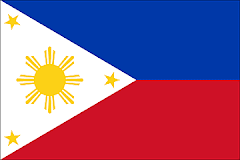


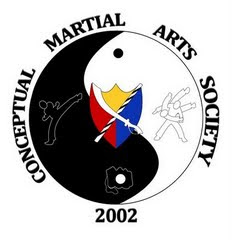


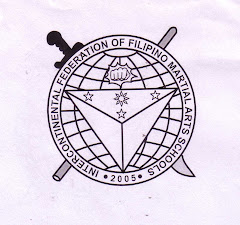

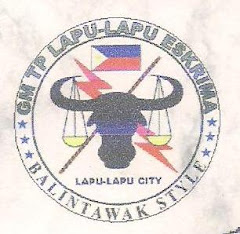






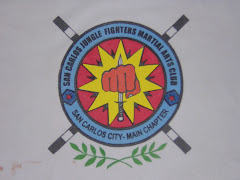



No comments:
Post a Comment